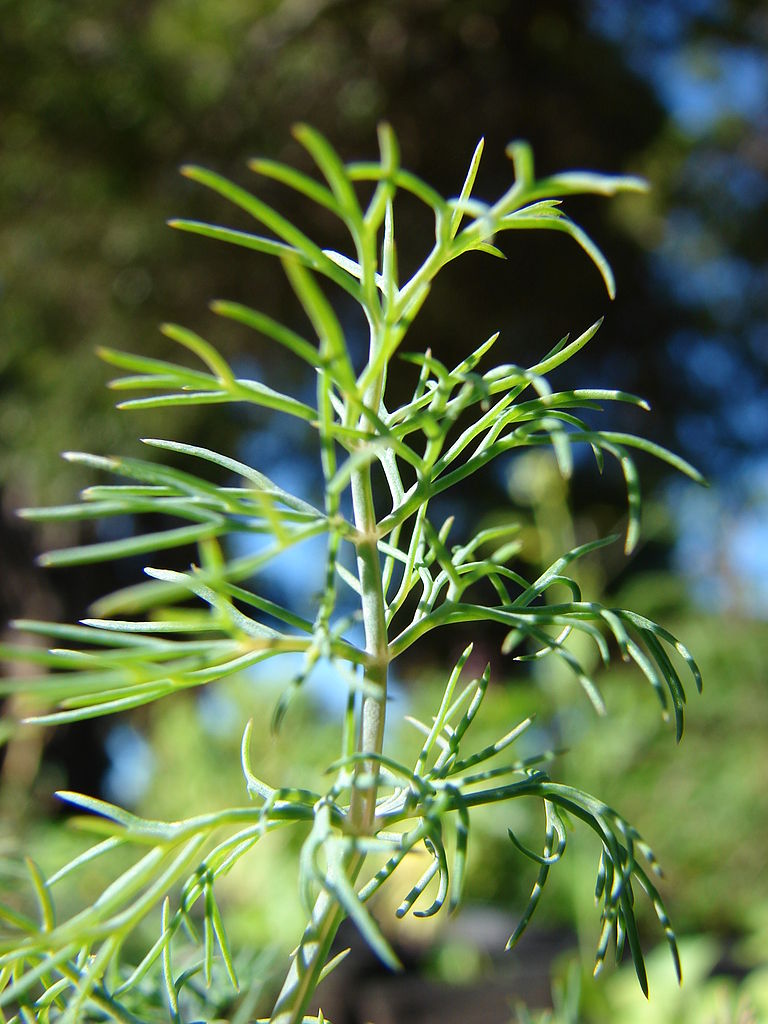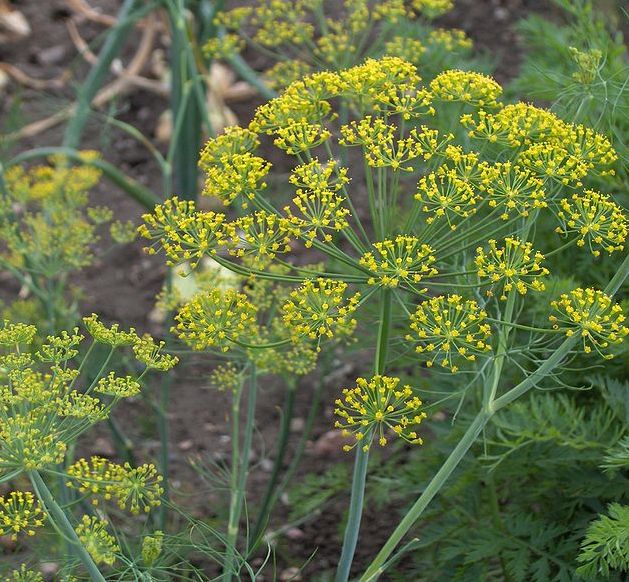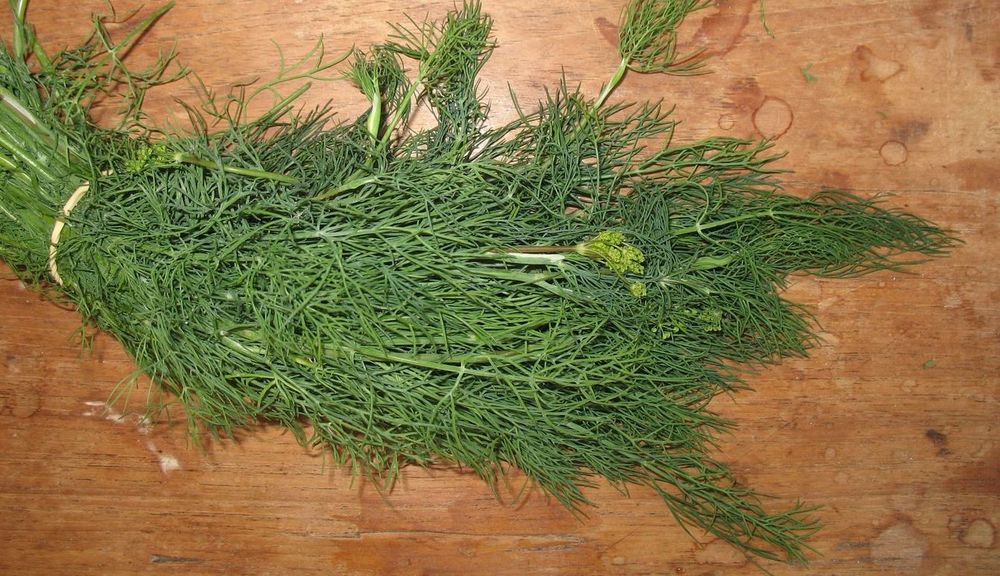Dill is an annual herbaceous plant characterized by its foliage composed of thin strips of gray-green and by its yellow flowers in umbels, characteristic of the family Umbelliferae which includes carrots, parsley, celery, coriander … etc.
The origin of the Dill is uncertain, probably between Asia and Europe, probably in Central Asia. What is certain is that this aromatic plant is already known in ancient Egypt, that it is quoted in the Gospels and that an ordinance of Charlemagne recommends it to be cultivated in the monasteries. Moreover, its name comes from the Greek anêthon (which also gives anise); the determinant graveolens means strong smelling (from the Latin gravis: heavy, and olens: smelling).
It is not known at what time this plant was introduced in the Indochinese peninsula because the old texts often confuse three plants having a little the same odor: the fennel, the anise and the dill. This one would be especially cultivated in Vietnam and in Laos where some consider that it is a typical flavor of the local cooking. It is very little found in Cambodia, and in Thailand it is called plak si lao; Thai literature considers that the cuisine of Issan, a region populated by Lao people, is marked by three flavors: plak si lao, plak si farang (Eryngium foetidum, phak hom phé in Lao) and plak phai (Polygonum odoratum, phak phèo in Lao) Phak si has adapted so well to the Lao country that it is one of the essential ingredients in the preparation of o lam, a specialty of Luang Prabang. It is also used in many mok, preferably those made with fish and especially with brains; it can be found raw in some Western-style salads and in koy pa. Some Lao also enjoy a dill flower omelet for breakfast.
If the Lao use only the leaves and flowers of Dill, other people also appreciate the seeds which are a classic spice in Scandinavia, Russia, Poland, but also in Central Asia, Georgia, Iran and India. In these regions the plant has sometimes a magical and especially medicinal value. Like all aromatic plants, Dill is good for digestive disorders, but also for hiccups, headaches, children’s coughs. In Laos we have not collected any therapeutic indications for phak si but it is safe to drink after each meal a cup of the infusion of 30gr of leaves or seeds to digest well. Phak si can also be recommended to breastfeeding women as a stimulant of milk secretions, but it should be forbidden to pregnant women as it is potentially toxic for the embryo.
L’Aneth est une plante herbacée annuelle caractérisée par son feuillage composé de fines lanières d’un vert gris et par ses fleurs jaunes en ombelles, caractéristiques de la famille des Ombellifères qui comprend entre autres les carottes, le persil, le cèleri, la coriandre…etc.
L’origine de l’Aneth est incertaine, sans doute entre l’Asie et l’Europe, probablement en Asie centrale. Ce qui est certain c’est que cette plante aromatique est connue déjà dans l’Egypte ancienne, qu’elle est citée dans les Evangiles et qu’une ordonnance de Charlemagne la recommande pour être cultivée dans les monastères. D’ailleurs son nom vient du grec anêthon (qui donne aussi anis); le déterminant graveolens signifie à odeur forte (du latin gravis: lourd, et olens: sentant ).
On ne sait pas à quelle époque cette plante a été introduite dans la péninsule indochinoise car les textes anciens confondent souvent trois plantes ayant un peu la même odeur: le fenouil, l’anis et l’aneth. Celle-ci serait surtout cultivée au Vietnam et au Laos où certains considèrent qu’elle est une saveur typique de la cuisine locale. On la trouve très peu au Cambodge, et, en Thaïlande, on la nomme plak si lao; la littérature thaïe estime d’ailleurs que la cuisine de l’Issan, région peuplée de Lao, est marquée par trois saveurs: celle de plak si lao, celle de plak si farang (Eryngium foetidum, phak hom phé en lao) et celle de plak phai (Polygonum odoratum, phak phèo en lao). Phak si s’est si bien adaptée au pays lao qu’elle est l’un des ingrédients indispensables à la préparation du o lam, spécialité de Louang Prabang. On met aussi cette plante à saveur anisée dans de nombreux mok, de préférence ceux qui sont à base de poisson et surtout de cervelle; on peut la trouver crue dans certaines salades à la mode occidentale et dans le koy pa. Certains Lao apprécient également pour leur petit déjeuner une omelette aux fleurs d’Aneth.
Si les Lao n’utilisent que les feuilles et les fleurs de l’Aneth, d’autres peuples en apprécient aussi les graines qui sont une épice classique en Scandinavie, Russie, Pologne, mais aussi en Asie centrale, Géorgie, Iran et en Inde. Dans ces régions la plante a parfois une valeur magique et surtout médicinale. Comme toutes les plantes aromatiques l’Aneth est bonne pour les troubles de la digestion, mais aussi pour le hoquet, les maux de tête, la toux des enfants. Au Laos nous n’avons pas recueilli d’indications thérapeutiques pour phak si mais l’on peut sans danger boire après chaque repas une tasse de l’infusion de 30gr de feuilles ou graines pour bien digérer. Phak si peut également être conseillée aux femmes qui allaitent comme stimulant des sécrétions lactées, mais elle doit être interdite aux femmes enceintes comme potentiellement toxique pour l’embryon.



Dill is an annual herbaceous plant characterized by its foliage composed of thin strips of gray-green and by its yellow flowers in umbels, characteristic of the family Umbelliferae which includes carrots, parsley, celery, coriander … etc.
The origin of the Dill is uncertain, probably between Asia and Europe, probably in Central Asia. What is certain is that this aromatic plant is already known in ancient Egypt, that it is quoted in the Gospels and that an ordinance of Charlemagne recommends it to be cultivated in the monasteries. Moreover, its name comes from the Greek anêthon (which also gives anise); the determinant graveolens means strong smelling (from the Latin gravis: heavy, and olens: smelling).
It is not known at what time this plant was introduced in the Indochinese peninsula because the old texts often confuse three plants having a little the same odor: the fennel, the anise and the dill. This one would be especially cultivated in Vietnam and in Laos where some consider that it is a typical flavor of the local cooking. It is very little found in Cambodia, and in Thailand it is called plak si lao; Thai literature considers that the cuisine of Issan, a region populated by Lao people, is marked by three flavors: plak si lao, plak si farang (Eryngium foetidum, phak hom phé in Lao) and plak phai (Polygonum odoratum, phak phèo in Lao) Phak si has adapted so well to the Lao country that it is one of the essential ingredients in the preparation of o lam, a specialty of Luang Prabang. It is also used in many mok, preferably those made with fish and especially with brains; it can be found raw in some Western-style salads and in koy pa. Some Lao also enjoy a dill flower omelet for breakfast.
If the Lao use only the leaves and flowers of Dill, other people also appreciate the seeds which are a classic spice in Scandinavia, Russia, Poland, but also in Central Asia, Georgia, Iran and India. In these regions the plant has sometimes a magical and especially medicinal value. Like all aromatic plants, Dill is good for digestive disorders, but also for hiccups, headaches, children’s coughs. In Laos we have not collected any therapeutic indications for phak si but it is safe to drink after each meal a cup of the infusion of 30gr of leaves or seeds to digest well. Phak si can also be recommended to breastfeeding women as a stimulant of milk secretions, but it should be forbidden to pregnant women as it is potentially toxic for the embryo.
L’Aneth est une plante herbacée annuelle caractérisée par son feuillage composé de fines lanières d’un vert gris et par ses fleurs jaunes en ombelles, caractéristiques de la famille des Ombellifères qui comprend entre autres les carottes, le persil, le cèleri, la coriandre…etc.
L’origine de l’Aneth est incertaine, sans doute entre l’Asie et l’Europe, probablement en Asie centrale. Ce qui est certain c’est que cette plante aromatique est connue déjà dans l’Egypte ancienne, qu’elle est citée dans les Evangiles et qu’une ordonnance de Charlemagne la recommande pour être cultivée dans les monastères. D’ailleurs son nom vient du grec anêthon (qui donne aussi anis); le déterminant graveolens signifie à odeur forte (du latin gravis: lourd, et olens: sentant ).
On ne sait pas à quelle époque cette plante a été introduite dans la péninsule indochinoise car les textes anciens confondent souvent trois plantes ayant un peu la même odeur: le fenouil, l’anis et l’aneth. Celle-ci serait surtout cultivée au Vietnam et au Laos où certains considèrent qu’elle est une saveur typique de la cuisine locale. On la trouve très peu au Cambodge, et, en Thaïlande, on la nomme plak si lao; la littérature thaïe estime d’ailleurs que la cuisine de l’Issan, région peuplée de Lao, est marquée par trois saveurs: celle de plak si lao, celle de plak si farang (Eryngium foetidum, phak hom phé en lao) et celle de plak phai (Polygonum odoratum, phak phèo en lao). Phak si s’est si bien adaptée au pays lao qu’elle est l’un des ingrédients indispensables à la préparation du o lam, spécialité de Louang Prabang. On met aussi cette plante à saveur anisée dans de nombreux mok, de préférence ceux qui sont à base de poisson et surtout de cervelle; on peut la trouver crue dans certaines salades à la mode occidentale et dans le koy pa. Certains Lao apprécient également pour leur petit déjeuner une omelette aux fleurs d’Aneth.
Si les Lao n’utilisent que les feuilles et les fleurs de l’Aneth, d’autres peuples en apprécient aussi les graines qui sont une épice classique en Scandinavie, Russie, Pologne, mais aussi en Asie centrale, Géorgie, Iran et en Inde. Dans ces régions la plante a parfois une valeur magique et surtout médicinale. Comme toutes les plantes aromatiques l’Aneth est bonne pour les troubles de la digestion, mais aussi pour le hoquet, les maux de tête, la toux des enfants. Au Laos nous n’avons pas recueilli d’indications thérapeutiques pour phak si mais l’on peut sans danger boire après chaque repas une tasse de l’infusion de 30gr de feuilles ou graines pour bien digérer. Phak si peut également être conseillée aux femmes qui allaitent comme stimulant des sécrétions lactées, mais elle doit être interdite aux femmes enceintes comme potentiellement toxique pour l’embryon.






Dill is an annual herbaceous plant characterized by its foliage composed of thin strips of gray-green and by its yellow flowers in umbels, characteristic of the family Umbelliferae which includes carrots, parsley, celery, coriander … etc.
The origin of the Dill is uncertain, probably between Asia and Europe, probably in Central Asia. What is certain is that this aromatic plant is already known in ancient Egypt, that it is quoted in the Gospels and that an ordinance of Charlemagne recommends it to be cultivated in the monasteries. Moreover, its name comes from the Greek anêthon (which also gives anise); the determinant graveolens means strong smelling (from the Latin gravis: heavy, and olens: smelling).
It is not known at what time this plant was introduced in the Indochinese peninsula because the old texts often confuse three plants having a little the same odor: the fennel, the anise and the dill. This one would be especially cultivated in Vietnam and in Laos where some consider that it is a typical flavor of the local cooking. It is very little found in Cambodia, and in Thailand it is called plak si lao; Thai literature considers that the cuisine of Issan, a region populated by Lao people, is marked by three flavors: plak si lao, plak si farang (Eryngium foetidum, phak hom phé in Lao) and plak phai (Polygonum odoratum, phak phèo in Lao) Phak si has adapted so well to the Lao country that it is one of the essential ingredients in the preparation of o lam, a specialty of Luang Prabang. It is also used in many mok, preferably those made with fish and especially with brains; it can be found raw in some Western-style salads and in koy pa. Some Lao also enjoy a dill flower omelet for breakfast.
If the Lao use only the leaves and flowers of Dill, other people also appreciate the seeds which are a classic spice in Scandinavia, Russia, Poland, but also in Central Asia, Georgia, Iran and India. In these regions the plant has sometimes a magical and especially medicinal value. Like all aromatic plants, Dill is good for digestive disorders, but also for hiccups, headaches, children’s coughs. In Laos we have not collected any therapeutic indications for phak si but it is safe to drink after each meal a cup of the infusion of 30gr of leaves or seeds to digest well. Phak si can also be recommended to breastfeeding women as a stimulant of milk secretions, but it should be forbidden to pregnant women as it is potentially toxic for the embryo.
L’Aneth est une plante herbacée annuelle caractérisée par son feuillage composé de fines lanières d’un vert gris et par ses fleurs jaunes en ombelles, caractéristiques de la famille des Ombellifères qui comprend entre autres les carottes, le persil, le cèleri, la coriandre…etc.
L’origine de l’Aneth est incertaine, sans doute entre l’Asie et l’Europe, probablement en Asie centrale. Ce qui est certain c’est que cette plante aromatique est connue déjà dans l’Egypte ancienne, qu’elle est citée dans les Evangiles et qu’une ordonnance de Charlemagne la recommande pour être cultivée dans les monastères. D’ailleurs son nom vient du grec anêthon (qui donne aussi anis); le déterminant graveolens signifie à odeur forte (du latin gravis: lourd, et olens: sentant ).
On ne sait pas à quelle époque cette plante a été introduite dans la péninsule indochinoise car les textes anciens confondent souvent trois plantes ayant un peu la même odeur: le fenouil, l’anis et l’aneth. Celle-ci serait surtout cultivée au Vietnam et au Laos où certains considèrent qu’elle est une saveur typique de la cuisine locale. On la trouve très peu au Cambodge, et, en Thaïlande, on la nomme plak si lao; la littérature thaïe estime d’ailleurs que la cuisine de l’Issan, région peuplée de Lao, est marquée par trois saveurs: celle de plak si lao, celle de plak si farang (Eryngium foetidum, phak hom phé en lao) et celle de plak phai (Polygonum odoratum, phak phèo en lao). Phak si s’est si bien adaptée au pays lao qu’elle est l’un des ingrédients indispensables à la préparation du o lam, spécialité de Louang Prabang. On met aussi cette plante à saveur anisée dans de nombreux mok, de préférence ceux qui sont à base de poisson et surtout de cervelle; on peut la trouver crue dans certaines salades à la mode occidentale et dans le koy pa. Certains Lao apprécient également pour leur petit déjeuner une omelette aux fleurs d’Aneth.
Si les Lao n’utilisent que les feuilles et les fleurs de l’Aneth, d’autres peuples en apprécient aussi les graines qui sont une épice classique en Scandinavie, Russie, Pologne, mais aussi en Asie centrale, Géorgie, Iran et en Inde. Dans ces régions la plante a parfois une valeur magique et surtout médicinale. Comme toutes les plantes aromatiques l’Aneth est bonne pour les troubles de la digestion, mais aussi pour le hoquet, les maux de tête, la toux des enfants. Au Laos nous n’avons pas recueilli d’indications thérapeutiques pour phak si mais l’on peut sans danger boire après chaque repas une tasse de l’infusion de 30gr de feuilles ou graines pour bien digérer. Phak si peut également être conseillée aux femmes qui allaitent comme stimulant des sécrétions lactées, mais elle doit être interdite aux femmes enceintes comme potentiellement toxique pour l’embryon.


